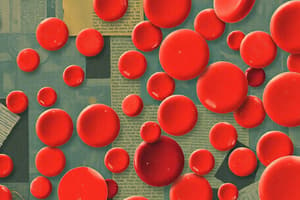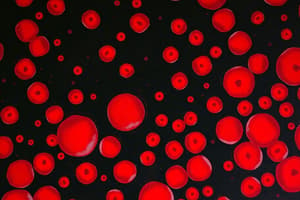Podcast
Questions and Answers
What characterizes a Haemolytic Anaemia compared to normal conditions?
What characterizes a Haemolytic Anaemia compared to normal conditions?
- RBC destruction exceeds RBC production without bone marrow compensation (correct)
- RBC production equals RBC destruction
- RBC production exceeds RBC destruction
- RBC destruction exceeds RBC production with bone marrow compensation
What is the primary clinical manifestation of excess haemolysis?
What is the primary clinical manifestation of excess haemolysis?
- Shortness of breath
- Jaundice (correct)
- Fatigue
- Pallor
Which statement is true regarding extravascular haemolysis?
Which statement is true regarding extravascular haemolysis?
- It results in the disordered breakdown of hemoglobin
- It occurs within the kidneys
- It accounts for less than 10% of total hemoglobin breakdown
- It is responsible for 90-95% of hemoglobin breakdown (correct)
How is RBC production affected in a Haemolytic Anaemia?
How is RBC production affected in a Haemolytic Anaemia?
What is the initial condition before the onset of a Haemolytic State?
What is the initial condition before the onset of a Haemolytic State?
What is a well-known consequence of excess intravascular hemolysis in hemolytic anemia?
What is a well-known consequence of excess intravascular hemolysis in hemolytic anemia?
Which laboratory test confirms increased red blood cell production in hemolytic anemia?
Which laboratory test confirms increased red blood cell production in hemolytic anemia?
What is the primary role of haptoglobins in hemolytic anemia?
What is the primary role of haptoglobins in hemolytic anemia?
Which symptom is specifically associated with hemolytic anemia and can result from excessive extravascular hemolysis?
Which symptom is specifically associated with hemolytic anemia and can result from excessive extravascular hemolysis?
Which of the following interventions is commonly utilized for the treatment of hemolytic anemias?
Which of the following interventions is commonly utilized for the treatment of hemolytic anemias?
An increase in which laboratory value is often indicative of hemolysis?
An increase in which laboratory value is often indicative of hemolysis?
What is the underlying reason for 'bossing' of the bone in certain types of anemia?
What is the underlying reason for 'bossing' of the bone in certain types of anemia?
What is the initial change observed in routine laboratory tests for a patient with hemolytic anemia?
What is the initial change observed in routine laboratory tests for a patient with hemolytic anemia?
Which of the following is a mechanism classified as intrinsic in haemolytic anaemias?
Which of the following is a mechanism classified as intrinsic in haemolytic anaemias?
What type of anaemia results from defective metabolic pathways making RBCs susceptible to stress?
What type of anaemia results from defective metabolic pathways making RBCs susceptible to stress?
Which of the following is NOT a characteristic of hereditary haemolytic anaemias?
Which of the following is NOT a characteristic of hereditary haemolytic anaemias?
Which condition is characterized by an acquired defect of all blood cells making them sensitive to complement activity?
Which condition is characterized by an acquired defect of all blood cells making them sensitive to complement activity?
In the context of extrinsic acquired haemolytic anaemias, which of the following is not considered a non-immune reaction?
In the context of extrinsic acquired haemolytic anaemias, which of the following is not considered a non-immune reaction?
Which type of haemolytic anaemia results from substitutions in amino acids and deletions in globin chains?
Which type of haemolytic anaemia results from substitutions in amino acids and deletions in globin chains?
Which of the following conditions is categorized under inherited enzymes deficiency leading to hemolytic anemia?
Which of the following conditions is categorized under inherited enzymes deficiency leading to hemolytic anemia?
Which treatment is intended to support erythropoiesis in hemolytic anemia?
Which treatment is intended to support erythropoiesis in hemolytic anemia?
Flashcards
Haemolytic Anaemia
Haemolytic Anaemia
A condition where RBC destruction exceeds production, affecting overall blood health.
RBC production vs destruction
RBC production vs destruction
Normal state occurs when RBC production equals destruction; haemolytic state when destruction exceeds production, with potential for anaemia.
Extravascular Haemolysis
Extravascular Haemolysis
Breakdown of RBCs outside blood vessels, primarily in the spleen; accounts for 90-95% of Hb breakdown.
Clinical sign of haemolysis
Clinical sign of haemolysis
Signup and view all the flashcards
Confirmatory laboratory tests
Confirmatory laboratory tests
Signup and view all the flashcards
Haptoglobins
Haptoglobins
Signup and view all the flashcards
Jaundice
Jaundice
Signup and view all the flashcards
Signs & Symptoms of Anaemia
Signs & Symptoms of Anaemia
Signup and view all the flashcards
Reticulocyte Count
Reticulocyte Count
Signup and view all the flashcards
Laboratory Tests for Haemolytic Anaemias
Laboratory Tests for Haemolytic Anaemias
Signup and view all the flashcards
Treatment Options for Haemolytic Anaemias
Treatment Options for Haemolytic Anaemias
Signup and view all the flashcards
Supportive therapy for erythropoiesis
Supportive therapy for erythropoiesis
Signup and view all the flashcards
Classification of Haemolytic Anaemias
Classification of Haemolytic Anaemias
Signup and view all the flashcards
Intrinsic Defects
Intrinsic Defects
Signup and view all the flashcards
Extrinsic Defects
Extrinsic Defects
Signup and view all the flashcards
Intrinsic Hereditary Haemolytic Anaemias
Intrinsic Hereditary Haemolytic Anaemias
Signup and view all the flashcards
Membranopathies
Membranopathies
Signup and view all the flashcards
Enzymopathies
Enzymopathies
Signup and view all the flashcards
Extrinsic Acquired Haemolytic Anaemias
Extrinsic Acquired Haemolytic Anaemias
Signup and view all the flashcards
Study Notes
Haemolytic Anaemias
- Haemolytic anaemia is a condition where red blood cell (RBC) destruction exceeds RBC production.
- Normal RBC production is greater than RBC destruction, however a haemolytic state results where RBC destruction is greater than RBC production when compensation mechanisms (Bone Marrow, BM) are not effective.
- In a haemolytic anaemia, RBC destruction is greater than RBC production exceeding compensation mechanisms
- Senescent RBCs (lifespan of 100-120 days) breakdown haemoglobin (Hb) in the red blood cells both extravascularly and intravascularly
- Extravascular haemolysis constitutes approximately 90-95% of total Hb breakdown
Extravascular Haemolysis
- Hb breakdown occurs within the reticuloendothelial system (RES), such as the spleen.
- The breakdown process is an orderly one, effectively recycling haemoglobin components.
Intravascular Haemolysis
- Hb is broken down within the blood vessels.
- Haptoglobins bind to Hb to prevent its loss in excess
- When haptoglobin levels are exceeded, Hb is lost.
General Clinical Features of Haemolytic Anaemia
- General anaemia symptoms such as shortness of breath (SOB), fatigue, pale mucous membranes, and dizziness.
- Symptoms from excess RBC destruction, include jaundice (localised or systemic excess extravascular), haemoglobinuria, haemosiderinuria (excess intravascular), and bone "bossing" (compensation for BM)
Diagnosis of Haemolytic Anaemias: Routine Laboratory Tests
- Reduced haemoglobin (Hb), packed cell volume (PCV)/haematocrit (Hct), and red blood cell (RBC) count.
- Normal red cell indices (N/N*).
- Increased reticulocyte count, which measures the rate of RBC production.
- Slide analysis revealing schistocytes (fragmented RBCs) and specific poikilocytosis (abnormal RBC shapes).
- Elevated bilirubin (total), lactate dehydrogenase (LDH), and reduced/absent haptoglobin.
- Direct antiglobulin test (DAT) may be positive or negative.
Diagnosis of Haemolytic Anaemias: Confirmatory Laboratory Tests
- Signs and symptoms aid in determining the cause of haemolytic anaemia.
- Examination of red blood cells (RBCs) morphologies.
- Selection of specific confirmatory tests identifies the specific type.
Treatment Options for Haemolytic Anaemias
- Transfusions of blood products to increase RBC mass, and concurrent monitoring of iron (Fe2+) status and haemoglobin (Hb) levels.
- Splenectomy in cases of extravascular haemolysis to decrease the rate of RBC destruction.
- Analgesics for pain management.
- Supportive therapy including folic acid to support erythropoiesis.
- Exposure to ultraviolet (UV) light to reduce jaundice.
Classification of Haemolytic Anaemias
- Intrinsic (Intracorpuscular): Defects within the red blood cell. Examples include membrane defects (hereditary spherocytosis, elliptocytosis), enzyme deficiencies (glucose-6-phosphate dehydrogenase deficiency), and haemoglobinopathies (thalassemia, sickle cell disease).
- Extrinsic (Extracorpuscular): Defects outside the red blood cell. Examples include immune-mediated haemolytic anaemia, mechanical trauma, and infections.
Intrinsic Hereditary Haemolytic Anaemias
- Membranopathies: Defects in RBC membrane components.
- Enzymopathies: Deficiencies in metabolic enzymes affecting RBC stability.
- Haemoglobinopathies: Abnormal haemoglobin synthesis causing RBC structure and function abnormalities.
Intrinsic Acquired Haemolytic Anaemia
- Paroxysmal nocturnal haemoglobinuria (PNH) is an acquired defect of blood cells involving complement activity.
Extrinsic Acquired Haemolytic Anaemias
- Immune-mediated anaemia: Autoimmune or alloimmune responses against RBCs.
- Drug-induced anaemia: Reactions to certain drugs.
- Non-immune anaemia: Infections, mechanical damage, and chemical/physical stimuli.
Studying That Suits You
Use AI to generate personalized quizzes and flashcards to suit your learning preferences.



